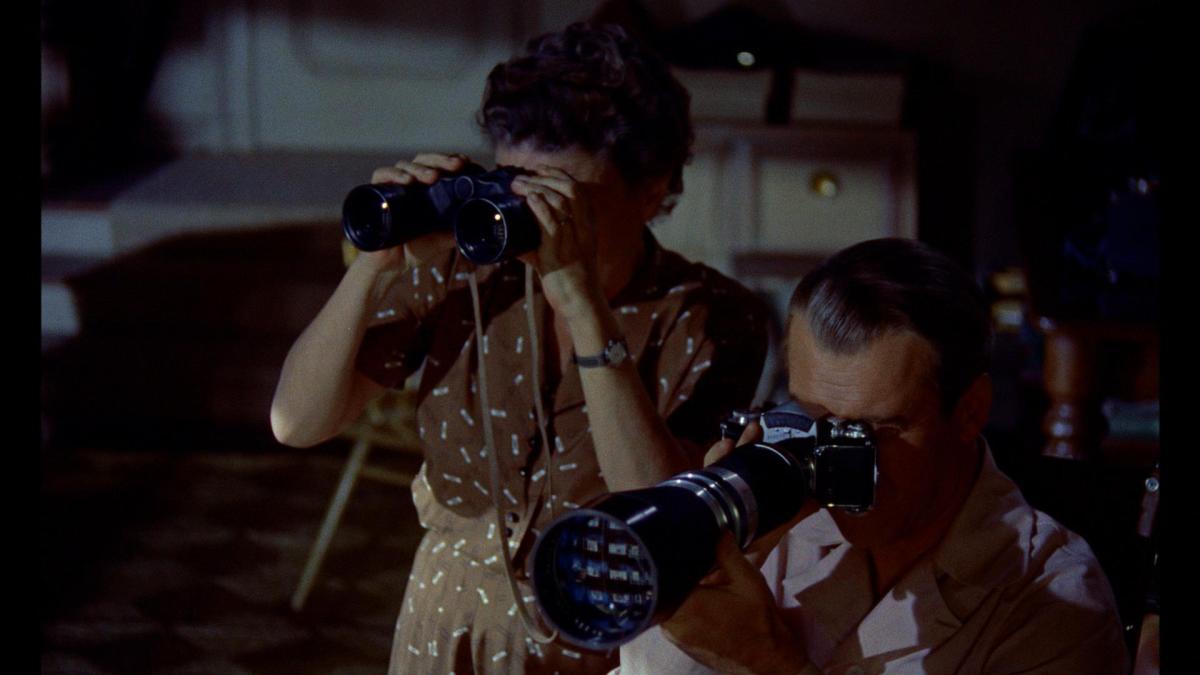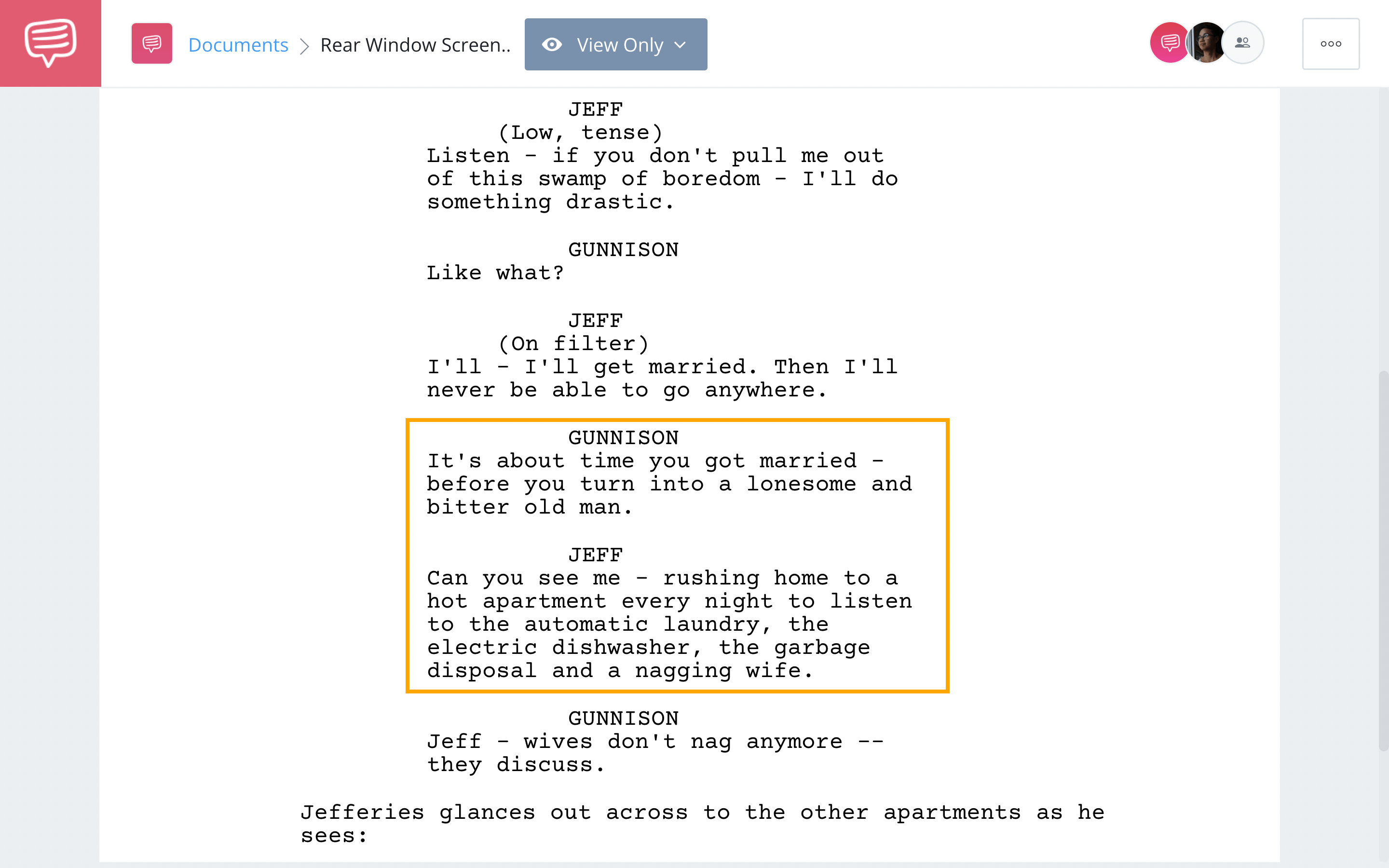Rear Window is a game of restraint. The rules of the film are clear: a murder mystery told through a window. The protagonist, and the camera, can’t leave the apartment. It’s a game Alfred Hitchcock was more than able to play, as Rear Window is now regarded as one of the greatest films of all time. And while Hitchcock deserves the credit for being able to keep a movie with such restrictions visually interesting and heart-pounding. Credit, too, should be allotted to the screenplay, a masterclass in the thriller genre. The Rear Window script crafts the perfect mystery, a satisfying love story, and an investigation of the nature of cinema itself, all while staying in one room.

WHO WROTE REAR WINDOW?
Written by John Michael Hayes
John Michael Hayes is an Oscar-nominated screenwriter. He started his career writing radio plays before moving to film to write multiple big-budget melodramas. He worked with Alfred Hitchcock on four films: Rear Window, To Catch a Thief, The Trouble with Harry and the second version of The Man Who Knew Too Much.
STORY BREAKDOWN
REAR WINDOW MOVIE PLOT SUMMARY
Here is the story structure for the Rear Window full script:
Exposition
We open on the bustling courtyard of L.B. Jefferies’ apartment complex, all seen from his apartment. He’s stuck in a wheelchair with a broken leg, and will be for the next week. He’s a traveling photographer who’s eager to get back on the road once that darned cast comes off.
Inciting Incident
Lisa Fremont, Jefferies’ girlfriend, arrives. She’s glamorous and clearly of a different ilk than Jeff.
Plot Point One
Lisa and Jeff argue: he doesn’t think she’d be able to handle his rough road lifestyle, and she believes they’re at a quagmire, since he won’t stay and she can’t go with him. She leaves, and just after, Jeff hears a scream.
Rising Action
Jeff stays up almost all night, watching Thorwald, a man in an apartment across from him, behave suspiciously. The next day, Jeff becomes convinced that Thorwald has murdered his invalid wife.
Midpoint
After being initially disturbed by Jeff’s obsession, Lisa finally comes on board when she sees Thorwald tying up a massive suitcase — does it hold his dead wife?
Plot Point Two
Jeff and Lisa are at a dead end, having been dismissed by Jeff’s detective friend Tom Doyle, until they see that a neighbor’s dog has been killed. It had been digging around the garden where they believe the wife is buried.
Build Up
Jeff, Lisa, and Jeff’s nurse, Stella, take action into their own hands. The women dig through the garden but find nothing. Lisa sneaks into Thorwald’s apartment, where she finds the wife’s ring but also blows their cover, getting caught by Thorwald.
Climax
Thorwald confronts Jefferies in his own apartment. Jeff tries to defend himself, but is defenestrated by Thorwald. His fall is slightly broken by police officers.
Finale
Even though he now has casts on both legs, Jefferies sleeps contentedly, having been proven correct. Lisa lies next to him, reading a book on the Himalayas before switching to a fashion magazine.
Rear Window Characters
Rear Window builds character fast
Rear Window is an incredibly economical film, establishing characters and plot points clearly and efficiently. Just five minutes into Rear Window, we know everything we need to know about the film’s protagonist, L.B. Jefferies.
John Michael Hayes does this with an ingenious opening conversation between Jefferies and his magazine editor, Gunnison. Let’s take a look at the scene, which we’ve imported into StudioBinder’s screenwriting software. Be sure to click the image to see the entirety of the sequence on the page.
Rear Window characters • Read Rear Window Quotes
Let’s go through everything we’ve learned about Jeff from this conversation:
- He’s a photographer: “I’ve been taking pictures so long I don’t know how to read anymore.”
- He’s a restless thrill seeker: “If you don’t pull me out of this swamp of boredom — I’ll do something drastic.”
- He was injured on the job: “I didn’t ask you to stand in the middle of that automobile racetrack.”
- He’s reluctant to settle down and get married: “Can you see me… [with] a nagging wife.”
- He has only a week left with his cast: “Next Wednesday I emerge from this plaster cocoon.”
This has all been established with one conversation with his editor. The crux of his character and the character arc he’ll embark on throughout the film — he’s someone who loves adventure, and both his cast and his girlfriend seem to be holding him back from that goal — are emphasized.
Packing this much information into one exchange, especially the first exchange of your film, can be a risky move, threatening to overwhelm or put off the audience with exposition. But Hayes writes the conversation naturalistically, and, perhaps more importantly, Hayes is also setting up the neighborhood in which Jefferies lives.
Let’s look at how this scene plays out on screen, as Alfred Hitchcock takes full advantage of Hayes’ script.
Rear Window opening scene • Rear Window quotes
This is the most important takeaway of Hayes’ opening scene. The conversation between Jefferies and Gunnison isn’t a simple back and forth. As Jefferies talks to Gunnison, he is scanning his courtyard, taking in the small dramas transpiring in each window.
This way, the audience isn’t bored by a lengthy, sedentary dialogue scene. Instead, we watch what Jefferies watches: the colorful cast of characters that will be recurring throughout the film going about their lives.
Hayes pays as much attention to what Jeff is seeing as he does to the conversation he’s having, inserting lengthy and precise description of everything going on outside his window (it should be noted that this type of stage direction dates the screenplay — today, it’s a no-no to write SD’s like the prose of a novel, but in the 1950s it was more common).
This roaming camera, following Jefferies’ eyeline throughout the conversation, soaks in the lengthy descriptions laid out by Hayes with casual ease. It also emphasizes the final key insight into Jeff’s character: he’s a voyeur.
REAR WINDOW SCRIPT TAKEAWAY #2
Rear Window knows its themes
What makes Rear Window not a good movie but a great one is its firm command of theme — primarily, that of voyeurism. The Rear Window script is a complicated look into the nature of voyeurism, and how it reflects the nature of cinema.
It’s no coincidence that the film opens with the curtains of Jefferies’ apartment being pulled to reveal the courtyard as though it were a stage at the beginning of a show. Hitchcock and Hayes deliberately draw the comparison between voyeurism and cinema throughout the film.
Again, Hitchcock of course deserves much of the credit for this preoccupation, as his use of point-of-view blurs the lines between Jefferies as protagonist and audience member.
But Hayes, too, does lots of work in the screenplay to hammer this theme home. Let’s look at an early scene introducing Jeff’s nurse, Stella:
Rear Window quotes • Read Stella Introduction
It’s a fantastic exchange because, like the opening conversation between Jefferies and Gunnison, it’s doing multiple things at once. Firstly, it’s giving us a strong introduction of Stella and what her role will be throughout the film: a tell-it-like-it-is nurse who acts as the voice of reason. She’s jovial and funny, a nice reprieve from the self-seriousness of Jefferies and Lisa.
Secondly, it’s an almost-explicit statement on the major theme of the film. Initially, Stella levels the accusation specifically at Jeff, teasing him that he’s going to be sent to a workhouse. Then, however, she has a more telling line: “We’ve grown to be a race of peeping Toms. What people should do is stand outside their own houses and look in once and a while.”
It’s an indictment not just of Jefferies but of the audience. By the 1950s, film had become the dominant commercial medium in America. And watching a film is, yes, watching — an act of voyeurism in and of itself. Stella was right: we had grown to become a race of peeping Toms.

In the end, Stella peeps too • Screenplay Rear Window
Then there’s the second half of the line (“what people should do…”). Again, an indictment of the audience, but also very applicable to Jefferies. He is a character sublimating his complicated feelings about Lisa into playing detective in a murder mystery.
Sure, he might end up being right, but that doesn’t change the fact that his obsession with peeping is ultimately an act of avoidance — he doesn’t want to look into his own house.
It’s only by the end of the film, when Thorwald violently barges into Jefferies’ apartment and, in turn, ends his removed voyeurism, that Jeff is forced to face hard truths. He might end up with two broken legs, but he’s better for it. In the final shot, he’s facing away from the window, eyes closed, now content to be by the side of Lisa.
Screenplay Rear Window
Rear Window tells stories visually
By the very nature of the story it’s telling, some of the most important story beats of Rear Window (indeed, most of them) are written visually, with little or no dialogue.
This is a daunting task for any screenwriter, since dialogue is often what pops the most in the format. But Hayes is able to emphasize these important beats with skillful stage direction writing.
Let’s take a look at how Hayes orchestrated one of the most important scenes of the film on the page (in order to read the entire scene, click the image).
Rear Window ending • Read Rear Window Ending
This is arguably one of the most frightening sequences, since Lisa is now in the same room as Thorwald and Jeff’s cover gets blown.
Each beat of this crucial scene is written precisely, indicating exactly what the audience should see and when. This type of detail also tells a director about pacing. Look specifically at the paragraph where Thorwald sees Lisa pointing at her finger.
Hayes gives us every minute detail, including camera movement. The note of Thorwald looking “directly into the lens” is particularly revealing. The breaking of the fourth wall is important because we as the audience know we’re in point of view, and that Thorwald is seeing Jeff.
A fourth wall break is also jarring, and jarring is exactly what Hayes and Hitchcock want for this shot. The voyeur is finally involved, and therefore so is the audience.
This type of detail is not super common in screenplays, but Hayes gets away with it for a few reasons. As mentioned before, scripts in the 1950s often had more verbose stage direction. But, additionally, Hayes was also working very closely with Hitchcock as he was writing.
It can be assumed, then, that Hitchcock was the one dictating exactly what the camera moves should be, and Hayes inserted them into the script.
Let’s take a look at how the final result turned out:
Rear Window ending
It’s pitch-perfect suspense. Hayes' attention to detail mediates the excruciatingly glacial pace of the scene. There’s some dialogue ornamenting the action, but try watching the sequence without sound.
Everything happening makes total sense, and the climactic shot of Thorwald looking at us hits just as hard. This is masterful direction paired with a script that knows exactly what it’s doing.
Related Posts
UP NEXT
Read and download more scripts
Even though it was made almost 70 years ago, Rear Window continues to inspire screenwriters and directors looking to craft a powerful thriller to this day. If you want to continue reading screenplays, we have similar titles like Halloween, Ex Machina, and Fight Club in our screenplay database. Browse and download PDFs for all of our scripts as you read, write and practice your craft to become the next great screenwriter.





Thanks ,very informative and helpful guide especially for me as a new student in the industry